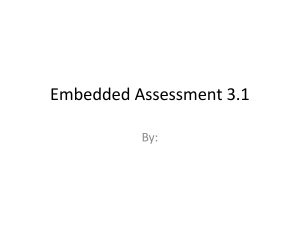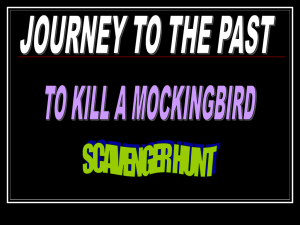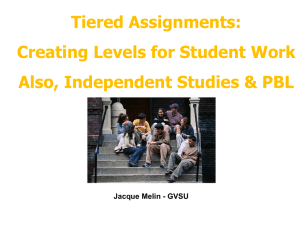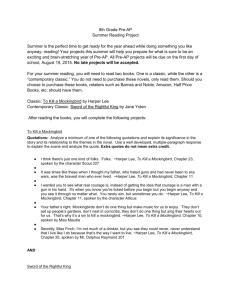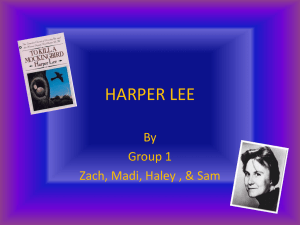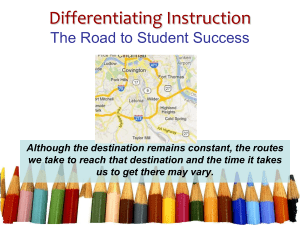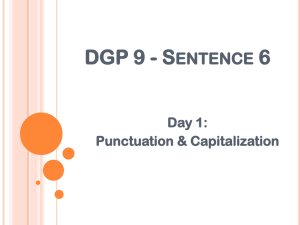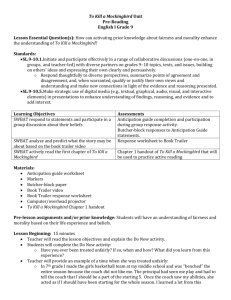File - Formative Assessment and Differentiated Instruction
advertisement
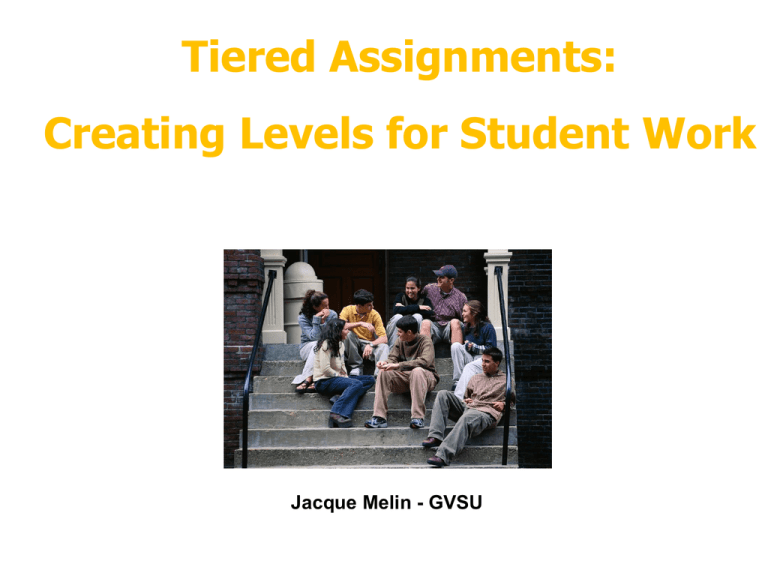
Tiered Assignments: Creating Levels for Student Work Jacque Melin - GVSU Tiering is… A form of differentiation Differentiation according to readiness Based upon students’ readiness for a particular task Driven by preassessment NOT the only kind of differentiation, though it is foundational NOT locking students into “ability boxes” -groups are flexible and vary according to the task NOT more work or “better” work for some levels – tasks are equitable Tiered assignments should be: -Different work, not simply more or less work -Equally active -Equally interesting and engaging -Fair in terms of work expectations and time needed -Require the use of key concepts, skills, or ideas -Are used as practice or daily work, NOT as an assessment task to be graded. -Learn from each other – share work! How to Distribute Tiers Deciding on Who Gets Which Version on an Assignment Option 1—Everyone does Tier 1 Option 2—Let Students Choose a Tier Option 3—Put the Students into Cooperative Groups Option 4—All Tiers for All Students (Layered Curriculum) Option 5—The Teacher Decides Which Students Get Which Tiers Basic Elements Defining the Core Curriculum Process: Thinking Skills Content Process: Research Skills Product Thinking Skill Subject Matter Research Skills and/or Resources Culmination or Exhibition List The causes and effects of the Industrial Revolution After reading the text, pages 42-49. Write a paragraph to share the information. Differentiating the Core: Modifying the Process Element – Thinking Skills Process: Thinking Skills Content Process: Research Skills Product List The causes and effects of the Industrial Revolution After reading the text, pages 42-49. Write a paragraph to share the information. Judge with criteria The causes and effects of the Industrial Revolution After reading the text, pages 42-49. Write a paragraph to share the information. Differentiating the Core: Modifying the Process Element – Research Skills Process: Thinking Skills List Judge with criteria Content The causes and effects of the Industrial Revolution The causes and effects of the Industrial Revolution Process: Research Skills Product After reading the text, pages 42-49. Write a paragraph to share the information. Interview an American history professor at the university; use the Internet; and read the text, Chapter IV. Write a paragraph to share the information. Differentiating the Core: Modifying the Product Element Process: Thinking Skills List Judge with criteria Content The causes and effects of the Industrial Revolution The causes and effects of the Industrial Revolution Process: Research Skills Product After reading the text, pages 42-49. Write a paragraph to share the information. Interview an American history professor at the university; use the Internet; and read the text, Chapter IV. Write an editorial and debate the positive and negative consequences of the Industrial Revolution. Differentiating the Core: Modifying the Content Element Process: Thinking Skills List Judge with criteria Content The causes and effects of the Industrial Revolution The patterns in the behaviors and trends of consumers and producers who contributed to the causes and subsequent effects of the Industrial Revolution. Process: Research Skills Product After reading the text, pages 42-49. Write a paragraph to share the information. Interview an American history professor at the university; use the Internet; and read the text, Chapter IV. Write an editorial and debate the positive and negative consequences of the Industrial Revolution. 3 Levels of Challenge - CbC Green—Tasks are foundational and appropriate for the current grade level. Success depends on understanding and applying required knowledge and skills. Green level tasks meet a rigorous grade level proficiency standard. Blue—Tasks are advanced and complex. Success depends on extending one’s skills in order to recognize and address the added layers of complexity. Black—Tasks are extremely advanced and highly complex. Success depends on creatively applying and extending one’s skills, at times in very unfamiliar territory. Tiered Graphic Organizers Tier 1 Tiered Graphic Organizers Tier 2 Tiered Graphic Organizers Tier 3 Task/Work • Make sure the directions are clearly stated in studentfriendly language. • Include specific details (e.g., “Give a minimum of three examples”) • Include criteria for quality or a rubric so students clearly know your expectations for their work. • As appropriate, sequence the steps students need to follow. • Include examples or samples of work as necessary. • Explain how students will share their work. • Double-check that the directions can be followed by students independently. Task Cards/Work Cards Write a letter to yourself stating at least five key points that you would like to remember about differentiated instruction and how you will use these things in your classroom. Write a letter to your principal comparing what you have learned about differentiated instruction to what is happening in your school. Write a persuasive letter to your school board president convincing him/her that your school district must adopt the philosophy of differentiated instruction in your district. Layered Curriculum – Kathie Nunley “Between various learning profiles, various abilities and exceptionalities, multiple languages and cultures, I began to come to two very important conclusions. First, although I am considered a regular educator there are no regular students in my room. And secondly, every student deserves a special education.” Dr. Kathie Nunley Layer C • Foundation Layer • Basic knowledge and understanding • Students collect factual information in a learning style, reading level, and language that is most comfortable to him or her. Layer C • Can offer as little as 3 or 4 assignment choices or as many as 20. • Students will not do all assignments, but enough to accumulate point totals needed to move on to next layer. Example: 30 points are needed to move on. Each assignment worth 5 points, so student must do 6 Layer C assignments. Examples: • All lists of C layer activities should provide assignments for: -visual learners (reading, demos) -auditory learners (lecture, video) -tactile learners (models, flash cards) Layer B • According to Kathie Nunley, the “B” layer deals with “application or manipulation of the information learned in the C layer. Problem solving or other higher level thinking tasks can be placed here.” • Relates to application and analysis in Bloom’s Taxonomy Examples: • All “B” layer projects should be based upon information learned at the “C” layer – – – – – – Lab activities Designing a game for a specific topic Drawing a cartoon Designing a worksheet Brainstorming quiz/test questions Inquiry projects—designing a lab Layer A • Critical thinking about the topic. • Examining how the material integrates into the world around them. • Bloom’s taxonomy -- highest order – Synthesis – Evaluation Examples: • • • • • Experiments Research Power Points Podcasts, Movies, Websites Posters, Books Sidebars • SIDEBARS: Another way to differentiate instruction is to be ready for students who learn the material quickly and accurately. Teachers can create a “sidebar activity” for these students who have demonstrated successful completion of an assignment (or unit). A “sidebar activity” is an assignment that moves laterally across the curriculum to further strengthen student understanding and aptitude. It requires several class periods (or even longer, like an ongoing project). This is not “curriculum compacting” whereby the teacher accelerates faster students through the assigned curriculum. Rather, it is more of a “scenic turn-out” *from the assigned curriculum. (* Betty Shoemaker) • For example, here is a SideBar designed for US History students who successfully completed a reading notetaking assignment in their textbook. Sidebars Create a CliffsNotes study guide for a new student in our AP History course. This booklet must assist the student in learning how to take notes for this chapter. If you’d rather, create a “Note Taking in History for Dummies.” Your guide should include helpful tips for reading the textbook. For example: • how to distill 3-4 paragraphs from the chapter down to a couple of summary sentences. • how to locate key details that shed light on a main idea • how to generate study-review questions at various levels of complexity · quiz-type questions – recall basic information · essay-type questions – deeper information processing Your booklet could also include: • key vocabulary terms • study tips for learning and remembering historical information • illustrations / graphics to highlight important points Differentiation by Readiness English - To Kill a Mockingbird - Think Dots LEVEL 1 1) Describe the setting of To Kill a Mockingbird. 2) Explain an example of person vs. person in To Kill a Mockingbird. 3) From whose point of view is the story told? What clues tell you? 4) In a Venn Diagram, compare and contrast one of the characters in To Kill a Mockingbird to a character in a different book. 5) How do the citizens of Maycomb react to Atticus’s decision to defend Tom Robinson? Write about two examples. 6) Find three examples of the following in To Kill a Mockingbird: similes, metaphors, and idioms. Create a list. Differentiation by Readiness English - To Kill a Mockingbird - Think Dots (continued) LEVEL 2 1)Describe how the setting of To Kill a Mockingbird has influenced the story so far. 2)Explain at least three types of conflict with examples in To Kill a Mockingbird. 3)In what ways would the story be different if told from another character’s point of view? Give support for your opinion. “If only ______________ had been telling the story, it would have been different…” 4)In a Venn Diagram, compare and contrast the Ewells family and the Cunninghams family to a family in another movie. 5)In a newspaper article, explain how the local reaction to Atticus’s decision to defend Tom Robinson reflects the time period in which the novel takes place. Writer the newspaper article as it would have appeared during the setting of the novel. 6)What effect do the similes, metaphors, and idioms Harper Lee uses have on a reader’s understanding of the novel? Explain your thought in a critic’s blurb. Differentiation by Readiness English - To Kill a Mockingbird - Think Dots (continued) LEVEL 3 1)Describe at least three ways the setting is reflected in the context of To Kill a Mockingbird. 2)Explain the most significant sources of conflict in To Kill a Mockingbird. 3)In your opinion, what does the point of view tell you about Harper Lee? 4)In a Venn Diagram, compare and contrast Scout as a narrator to another narrator of a movie or story. 5)Apply the quote “What is right is not always popular. What is popular is not always right” as an epigraph to a short essay explaining Atticus Finch’s decision to defend Tom Robinson. 6)What kind of writing style does Harper Lee have? Provide examples to illustrate your point. Additional Resources for Tiered Assignments Danzi, J., Reul, K., & Smith, R. (2008). Improving student motivation in mixed ability classrooms using differentiated instruction. Retrieved from http://www.eric.ed.gov/ERICDocs/data/ericdocs2sql/content_storage_01/0000019b/80/3d/4e/ f0.pdf Lopez, D.M., & Schroeder, L. (2008). Designing strategies that meet the variety of learning styles of students. Retrieved from http://www.eric.ed.gov/ERICDocs/data/ericdocs2sql/content_storage_01/0000019b/80/3d/5b/d1.pdf Mawhinney, T.S. (2000). Finding the Answer. Principal Leadership, 4(1), Retrieved from http://leading4learning.com/Finding_the_Answer.pdf McQuarrie, L., McRae, P., & Stack-Cutler, H. (2008). Differentiated instruction provincial research review: Choice, complexity and creativity. Alberta Initiative for School Improvement (AISI). Rakow, S. (2007). All Means all: Cassrooms that work for advanced learners. Middle Ground: National Middle School Association, 11 (1), 10-12. Roberts, J., & Inman, T. (2007). Strategies for differentiating instruction best practices for the classroom. Waco, Texas: Prufrock Press Inc. Tomlinson, C. (1999). The differentiated classroom. New Jersey: Pearson. P. 83-87 Tomlinson, C.A., & Strickland, C.A. (2005). Differentiation in practice. Alexandria, VA, USA: Association for Supervision and Curriculum Development. 39
